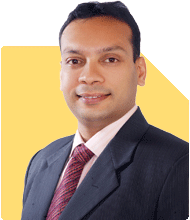53, Jobless, with House & Savings: What's Next?
Ramalingam Kalirajan |10908 Answers |Ask -Follow
Mutual Funds, Financial Planning Expert - Answered on Dec 09, 2024
He has an MBA in finance from the University of Madras and is a certified financial planner.
He is the director and chief financial planner at Holistic Investment, a Chennai-based firm that offers financial planning and wealth management advice.... more

hello Sir, I am 53 and have lost my job recently I have a house of my own, 2 crores in FD and no loan and no other source of income, my son is 15 years, i need your advise on how I proceed
Your house is your own, which reduces monthly expenses.
Your son is 15 years old, and his education is a priority.
You currently have no loans or liabilities, which is a strong starting point.
Now, you need to plan for monthly income, son's education, and your retirement.
Identifying Your Immediate Needs
Monthly Income
Fixed deposits provide safety but limited returns.
Interest from FDs may not be enough for monthly expenses.
Son’s Education
Higher education costs can be substantial in the next few years.
A dedicated plan is needed to secure his future.
Retirement Planning
You must secure your retirement without relying on others.
A well-diversified portfolio can generate growth and income.
Creating a Monthly Income Plan
Systematic Withdrawal Plan (SWP) in Mutual Funds
Invest a portion of Rs. 2 crores in balanced advantage funds.
Use an SWP to generate monthly income, which is tax-efficient.
Fixed-Income Instruments for Stability
Allocate a part to debt mutual funds or ultra-short-term funds.
These funds offer stability and liquidity for immediate needs.
Emergency Reserve
Keep Rs. 20–30 lakhs in a liquid fund for unforeseen expenses.
This ensures financial security during emergencies.
Planning for Son’s Education
Dedicated Education Fund
Invest in equity-oriented mutual funds for higher returns.
SIPs can help accumulate funds over the next few years.
Avoid Lock-in Products
Avoid ULIPs and other investment-cum-insurance plans.
Focus on transparent, high-return mutual funds.
Gradual Fund Utilisation
Start withdrawing funds closer to his higher education needs.
Use debt-oriented funds for stability during the withdrawal phase.
Retirement Corpus Growth
Diversify Investments
Allocate funds to a mix of equity and hybrid mutual funds.
This helps in growing your corpus over the next 10–15 years.
Avoid Risky Investments
Do not invest in speculative or high-risk products.
Safety and consistent growth are more important at this stage.
Periodic Portfolio Review
Review and rebalance your portfolio every six months.
Ensure it aligns with your income and retirement goals.
Tax Considerations
Mutual Fund Taxation
Long-term capital gains (LTCG) above Rs. 1.25 lakh in equity funds are taxed at 12.5%.
Short-term capital gains (STCG) are taxed at 20%.
For debt funds, gains are taxed as per your income tax slab.
Interest Income from FDs
FD interest is added to your taxable income.
Keep this in mind while withdrawing from fixed deposits.
Key Steps to Take Now
Create a Budget
List monthly expenses and plan withdrawals accordingly.
Avoid overspending to sustain your savings longer.
Consult a Certified Financial Planner
A Certified Financial Planner can help create a detailed investment strategy.
They can ensure your goals are met with minimal risk.
Regular Income and Growth Focus
Combine growth investments with income-generating assets.
This balance ensures long-term financial stability.
What to Avoid
Long-Term Lock-in Investments
Do not invest in products with high lock-in periods.
Liquidity is critical at this stage.
Index and Direct Mutual Funds
Index funds lack flexibility and active management.
Direct plans save costs but lack professional advice.
Relying Solely on Fixed Deposits
FDs alone may not provide adequate returns over time.
Diversify to include equity and hybrid mutual funds.
Final Insights
You are at a critical stage where careful planning is essential.
Focus on generating steady monthly income while ensuring your son’s education.
Allocate funds wisely to meet both immediate and future goals.
Regular reviews and disciplined withdrawals can sustain your savings for life.
Best Regards,
K. Ramalingam, MBA, CFP,
Chief Financial Planner,
www.holisticinvestment.in
https://www.youtube.com/@HolisticInvestment
You may like to see similar questions and answers below
Ramalingam Kalirajan |10908 Answers |Ask -Follow
Mutual Funds, Financial Planning Expert - Answered on May 26, 2024
Krishna Kumar | Answer |Ask -Follow
Workplace Expert - Answered on Jun 04, 2024
Ramalingam Kalirajan |10908 Answers |Ask -Follow
Mutual Funds, Financial Planning Expert - Answered on Jul 16, 2024
Ramalingam Kalirajan |10908 Answers |Ask -Follow
Mutual Funds, Financial Planning Expert - Answered on Jul 25, 2024
Ramalingam Kalirajan |10908 Answers |Ask -Follow
Mutual Funds, Financial Planning Expert - Answered on Aug 02, 2025
Ramalingam Kalirajan |10908 Answers |Ask -Follow
Mutual Funds, Financial Planning Expert - Answered on Dec 20, 2025
Ramalingam Kalirajan |10908 Answers |Ask -Follow
Mutual Funds, Financial Planning Expert - Answered on Dec 20, 2025
Naveenn Kummar |237 Answers |Ask -Follow
Financial Planner, MF, Insurance Expert - Answered on Dec 20, 2025
Ramalingam Kalirajan |10908 Answers |Ask -Follow
Mutual Funds, Financial Planning Expert - Answered on Dec 19, 2025
Nayagam P P |10859 Answers |Ask -Follow
Career Counsellor - Answered on Dec 19, 2025
Ramalingam Kalirajan |10908 Answers |Ask -Follow
Mutual Funds, Financial Planning Expert - Answered on Dec 19, 2025
Ramalingam Kalirajan |10908 Answers |Ask -Follow
Mutual Funds, Financial Planning Expert - Answered on Dec 19, 2025
Ramalingam Kalirajan |10908 Answers |Ask -Follow
Mutual Funds, Financial Planning Expert - Answered on Dec 19, 2025
Radheshyam Zanwar |6751 Answers |Ask -Follow
MHT-CET, IIT-JEE, NEET-UG Expert - Answered on Dec 19, 2025
Radheshyam Zanwar |6751 Answers |Ask -Follow
MHT-CET, IIT-JEE, NEET-UG Expert - Answered on Dec 19, 2025
























